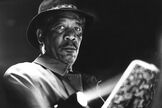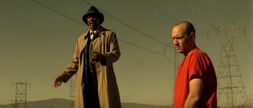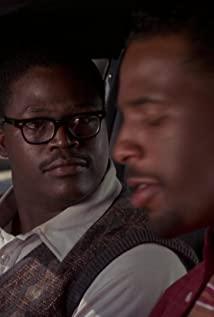Author: Jonathan Rosenbaum ( Chicago Reader , October 6, 1995)
Translator: csh
The translation was first published in "Iris"
Since when did the vomit of the artist, the nonsense of the pretenders, and other signifiers of depression, doom, and decline become the reassurance in the movie? I'm not just talking about Hollywood movies, but also Western movies as a whole. What made those violent, dirty raindrops land at the same time on "Satan Tango" (Bella Tal’s seven-hour Hungarian black comedy, which was screened at the Chicago International Film Festival last year) and "The Seven Deadly Sins" (A stylized, moving [albeit bloody] supernatural serial killer film)? Those rash critics blame it on "Blade Runner", film noir, and even the surrealism of the Prague School. This kind of argument makes us ignore the Calvinist/Expressionist presentation of urban filth and the post-Vietnam War psychopathology in "Taxi Driver". In fact, to explore its source may be a relatively pedantic approach, and the more important thing is to find out the source of the charm of this terrible emotion.
I think that part of the reason for this interest may be due to a certain kind of incompetence. We cannot believe or try a certain political change. In the United States, we cannot accept the fact that we are no longer the number one person. This is related to this kind of incompetence. connect. (Unfortunately, we have not been able to learn from the experience of the British. Some time ago, they had to deal with similar problems. Accepting our restrictions may actually promote our liberation.) In this negative Under the circumstances, rubbish, decay and doomsday become very attractive-this is a kind of spiritual heroin. If everything will eventually flow into this beautiful despair—if evil is everywhere and move forward ("Seven Deadly Sins" insists on this concept so powerfully), if human beings are always unable to break free from the primitive mud— -Then we are out of the predicament: we don't need to evaluate who we are, where we are, what we should do, we don't need to think about who is in charge of this performance, and the reason for all of this. The ability to observe violence and pain without flinching is usually seen as an indicator of world-weariness to assess sophistication and maturity-as long as there is such a posture of "everyone is drunk and I am alone" and sees through the rotten world, We can prove how correct we are to do as little as possible.
This kind of movie supports our passivity as consumers and citizens. We can soak in our own pessimism, as if taking a hot bath, caressing our sour indifference, as if it were a more advanced kind of indifference. Wisdom form. We will not regard our current state as the erosion of a few Western power bases (this situation may actually benefit the entire world), or the decline in government service capabilities. We prefer to regard it as a "civilization". The decline", because it sounds much more magnificent. We are still immersed in the terminology of the Cold War. What we do not realize is that the collapse of communism (or something wrongly identified as communism by both sides of the Cold War) does not necessarily mean that Marx is wrong, nor does it mean that Marx is wrong. We are right. (For many smaller countries, the similarities between Russia and the United States during and after the Cold War are more noticeable than differences.) In the production of commercial films, new ways of thinking are in a state of chronic lack— -Unless the concepts that are used repeatedly are called "new thinking"-more importantly, this reflects a rigid business policy, that is, to maximize the development of existing markets instead of exploring any new markets. Because it means taking risks and the need for creativity. Among those "overworked" genres, there is a movie that regards the desolation of the city as a transcendent, ecstatic situation, which is closely connected with metaphysical fatalism. The way to success of this type is to make all this look like a fresh idea, which is also the secret to the great success of The Seven Deadly Sins.
Some critics believe that this film is just a cliché and looks very false. I think that at the plot level, their view is correct. However, they ignored the things that made this film a great success. Generally speaking, we can use the freshness and credibility of the style to summarize this point. In other words, the appearance and texture of specific actors and sets are very appropriate. (For example, Morgan Freeman played a tired moral witness. He was a police detective who was on the verge of retirement, suffering from insomnia, and exhausted. For another example, we can see empty urban apartments with high ceilings. Hundreds of air fresheners are hung, and under the bedspread there is a tortured, skinny and still breathing human body.) These criticisms do not take into account the irritation of the opening subtitles-it is dry, rough, and a little harsh. The experimental passages of Stan Blahag seem to be the best work of Stan Blahag. Of the Hollywood movies I have watched this year, this is the most exciting passage for me. Of course, the brochure of this film didn't make me expect anything special. Its director, David Fincher, used music videos (he has worked with Madonna and the Rolling Stones), TV commercials, and "Alien 3" (in this film, the taste for dirty environments and religious fanatics is also Obviously) famous. Its screenwriter Andrew Kevin Walker is also a novice. He wrote the script while working as a floor keeper or cashier at the Tower Record Store in New York (depending on which page of the brochure you read).
At the beginning of "The Seven Deadly Sins," Detective Samose (played by Freeman) was in an unnamed, ordinary, and deserted city. In a bachelor’s apartment, he methodically put on his suit. Investigate the scene of a bloody multiple murder case. From the plot point of view, this seems to have nothing to do with the rest of the movie. We saw that he doubted whether the child who died on the spot had actually witnessed the death of his parents before he was killed. He was also reprimanded for this: a cruel and irritable colleague told him that none of this was related to the investigation. Then Samose met the detective Mills (Brad Pitt), a novice who was being trained to become Samose's successor, which also made Samose quite annoyed. Then, we saw the cast and crew. The serial killer has not yet appeared on the scene, but we saw a series of his objects or activities-maybe they also belonged to the police investigating the murderer later? This uncertainty seems to be important rather than accidental. We can catch a glimpse of photos, notebooks (with charming, neatly written words), film being stitched, something being stitched together. Then, the first day of the seven days-"Monday"-appeared at the bottom left of the screen. Samose and Mills were investigating an incident that was attributed to a series of unusually bloody and barbaric events that followed the seven deadly sins. The killing of civilians.
This structure of seven days and seven deadly sins is only part of the high-concept packaging of this film. In fact, many locations investigated by detectives have similar art designs—including damp and cold apartments belonging to the victims or murderers themselves. (Somewhat unreasonable is that although the film is set in the daytime, in most cases, the agents are investigating with flashlights-no one has ever wanted to bother to turn on the lights.) Just like "Blade Runner" , The heavy rain in this film is also continuous, even in the daytime, there is a feeling of endless night. The rotten interior and peeling walls seem to be part of evil activities, which are linked to the sordid anger of Calvinism towards contemporary urban life (as in "Taxi Driver").
The film’s high-concept expression of the modern world—which may ultimately be just an excuse for the Mannerist style—compares the two generations of Samosa and Mills in detail. It involves morality, maturity, temperament, and family relations. Even education (Mills delves into Dante, Chaucer, and Milton through the school outline, while Samose prefers the original.) There are many potentials that can be unearthed between this film and "The Silent Lamb." Among the comparisons, the most prominent point is that "The Seven Deadly Sins" refuses to use its mentally ill killer to obtain vulgar laughter or blind hero worship. But what’s not so pleasant is that it does, like "The Silent Lamb," praises the villain’s superhuman dedication and efficiency. This is obviously to create a weird and exaggerated texture. The creators Hope this role can be comparable to Hannibal's virtual halo. (The killer of "The Seven Deadly Sins" accumulated no less than two thousand two hundred and fifty-page notebooks, which were filled with his notes. He spent a whole year torturing a victim without killing him. Die him. He even made the victim bite off his tongue-this is reminiscent of Hannibal's superpowers, he induced the prisoner in the next cell to swallow his tongue.)
This apocalyptic swing dance replaced the horror in real life. It is believed that this horror is neither sufficient nor related to the incarnation of hell that the "Seven Deadly Sins" intends to present. After all, social consciousness has given way to metaphysics. The moving, old-fashioned, benevolent belief in the power of goodwill in the movie has re-proved its power - of course, this goes hand in hand with the premise of fashionableness: the martyrdom of the serial killer, Still the most true saint. In other words, even though "The Seven Deadly Sins" has great power, it is still a style exercise. The message it conveys is the same as most popular messages now: it allows us to stay in our place with peace of mind. superior.
View more about Se7en reviews











